语用学课程论文
- 格式:doc
- 大小:50.13 KB
- 文档页数:6

2014-2015学年第一学期语用学与英语教学课程考核(研究报告)题目:An analysis of Pragmatic Failure with Cross-cultural Communications学号(准考证号):1230100054姓名:焦凯丽专业:英语(教法方向)年级:2012级学院:外国语学院完成日期:2015年 1 月10日IntroductionThe Cross-cultural Pragmatics is a relatively young linguistic branch compared with the Traditional Linguistics and Structural Modern Linguistics. It attaches great importance to the research of cross-cultural characteristics. And the cross-cultural pragmatic failure is a common phenomenon in cross-cultural communication process. This paper focus on the analyzing of different kinds of pragmatic failures in our cross-cultural communication, at the same time, giving reflections and feedbacks on our English learning and Language teaching. Being in the rapid developed century of our human society, we should heighten the awareness of appropriating use of pragmatic language in our cross-cultural communication.Part I Theoretical basisBefore Noam Chomsky, Traditional Linguistics and Structural Modern Linguistics regarded language as a system of completely self-sufficient blocking structure, which put an emphasis on the vision field of language researches on the description of linguistic entity and put the language teaching on a cultural vacuum to conduct a rigid practice. But this failed to attach the expected research on the Social culture which affects the language how it affects the construction, comprehension and expression. As a result, linguistic theories couldn't resolve realistic problems of language. And often communicators who have learned some basic knowledge such as phonetic, lexicon and grammar still couldn't carry out proper and effective communication. The birth of sociolinguistics breaks through the research restriction of traditional linguistics and pragmatics and structural. It deepens people’s realization to linguistic social nature and construct a high qualified platform for the study of the Intercultural Communication. However, all kinds of failure still occur in the intercultural communication which influences the quality of international communication because communications cannot master enough foreign knowledge or acknowledge the culture feature of foreign nation. So the research of pragmatic failure in the cross-cultural communication has become a problem of important theoretic meaning and realistic value in the contemporary linguistic study.Cross-cultural Pragmatics is a relatively young linguistic branch, growing out of pragmatics and comparative linguistics, and introducing cultural factors into the research scope of pragmatics. It attracted great importance to the research of cross-cultural characteristics. Cross-cultural pragmatics is the study of the use of second language in cross-cultural speech communication when the pragmatic problem occurs. The conception pragmatic of pragmatic failure was formally proposed by the famous British scientist Jenny Thomas in her thesis "Cross一Cultural Pragmatic Failure" in 1983 which established a theoretical framework for the analysis of pragmatic failure and cultural transfer. She defines pragmatic failure as "inability to understand what is meant by what is said." Thus, Cross-cultural pragmatic failurecan refer to the misunderstanding and even conflict arising in the communication process because of the hearer's failure to catch discourse implication of the speaker accurately and because of his following improper output of utterances, which may be proper in his culture. The pioneer study of pragmatic failure in China goes to He Ziran and his fraternity. In 1984, they launched investigation into pragmatic differences between English and Chinese in reference to Thomas theory, and made known their results of investigation together with explanations about pragmatic failure. Cross-cultural pragmatic failure is a common phenomenon in cross-cultural communication process, in this process, the speaker disobeys the communication standard and social customs, ignores hearer's identity or status, harms the special cultural value of target language, causes the breaking off or failure of communication, makes communicating obstacles, then communication cannot achieve the expected results. Though there is no grammatical error, the wrong way of speaking or the improper performance makes the communication lose the expected effect.Part II Case studiesThere are many kinds of pragmatic failure in our cross-culture communication. First is about the phonetic pragmatic failure. A teacher who teach Chinese in England recalled that, ”My student, John is a typical English gentleman. When we walk down stairs, he always said that '请小心裸体(楼梯),下流,一起下流(下楼)吧。
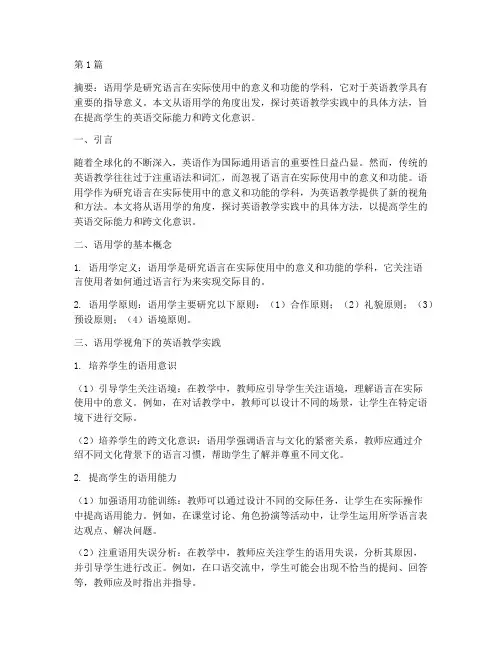
第1篇摘要:语用学是研究语言在实际使用中的意义和功能的学科,它对于英语教学具有重要的指导意义。
本文从语用学的角度出发,探讨英语教学实践中的具体方法,旨在提高学生的英语交际能力和跨文化意识。
一、引言随着全球化的不断深入,英语作为国际通用语言的重要性日益凸显。
然而,传统的英语教学往往过于注重语法和词汇,而忽视了语言在实际使用中的意义和功能。
语用学作为研究语言在实际使用中的意义和功能的学科,为英语教学提供了新的视角和方法。
本文将从语用学的角度,探讨英语教学实践中的具体方法,以提高学生的英语交际能力和跨文化意识。
二、语用学的基本概念1. 语用学定义:语用学是研究语言在实际使用中的意义和功能的学科,它关注语言使用者如何通过语言行为来实现交际目的。
2. 语用学原则:语用学主要研究以下原则:(1)合作原则;(2)礼貌原则;(3)预设原则;(4)语境原则。
三、语用学视角下的英语教学实践1. 培养学生的语用意识(1)引导学生关注语境:在教学中,教师应引导学生关注语境,理解语言在实际使用中的意义。
例如,在对话教学中,教师可以设计不同的场景,让学生在特定语境下进行交际。
(2)培养学生的跨文化意识:语用学强调语言与文化的紧密关系,教师应通过介绍不同文化背景下的语言习惯,帮助学生了解并尊重不同文化。
2. 提高学生的语用能力(1)加强语用功能训练:教师可以通过设计不同的交际任务,让学生在实际操作中提高语用能力。
例如,在课堂讨论、角色扮演等活动中,让学生运用所学语言表达观点、解决问题。
(2)注重语用失误分析:在教学中,教师应关注学生的语用失误,分析其原因,并引导学生进行改正。
例如,在口语交流中,学生可能会出现不恰当的提问、回答等,教师应及时指出并指导。
3. 优化教学策略(1)情境教学法:通过创设真实、生动的情境,让学生在实际语境中运用英语,提高语用能力。
(2)任务型教学法:设计具有实际意义的任务,让学生在完成任务的过程中,运用英语进行交流,提高语用能力。
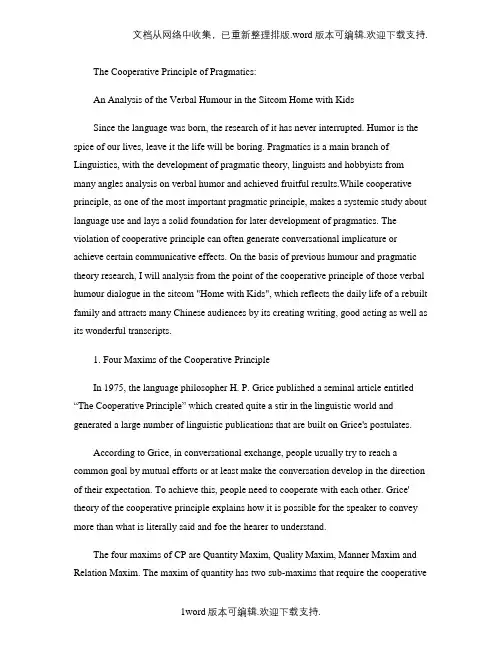
The Cooperative Principle of Pragmatics:An Analysis of the Verbal Humour in the Sitcom Home with KidsSince the language was born, the research of it has never interrupted. Humor is the spice of our lives, leave it the life will be boring. Pragmatics is a main branch of Linguistics, with the development of pragmatic theory, linguists and hobbyists from many angles analysis on verbal humor and achieved fruitful results.While cooperative principle, as one of the most important pragmatic principle, makes a systemic study about language use and lays a solid foundation for later development of pragmatics. The violation of cooperative principle can often generate conversational implicature or achieve certain communicative effects. On the basis of previous humour and pragmatic theory research, I will analysis from the point of the cooperative principle of those verbal humour dialogue in the sitcom "Home with Kids", which reflects the daily life of a rebuilt family and attracts many Chinese audiences by its creating writing, good acting as well as its wonderful transcripts.1. Four Maxims of the Cooperative PrincipleIn 1975, the language philosopher H. P. Grice published a seminal article entitled “The Cooperative Principle” which created quite a stir in the linguis tic world and generated a large number of linguistic publications that are built on Grice's postulates.According to Grice, in conversational exchange, people usually try to reach a common goal by mutual efforts or at least make the conversation develop in the direction of their expectation. To achieve this, people need to cooperate with each other. Grice' theory of the cooperative principle explains how it is possible for the speaker to convey more than what is literally said and foe the hearer to understand.The four maxims of CP are Quantity Maxim, Quality Maxim, Manner Maxim and Relation Maxim. The maxim of quantity has two sub-maxims that require the cooperativespeaker to say as much as but no more than is required for his particular purposes in the talk exchange. The maxim of quality also has two sub-maxims, which demands that the speaker say only what he believes to be true and for which he has sufficient evidence. The maxim of relation urges the speaker to make his contribution relevant to the communication context. The maxim of manner requires the speaker to be methodical and to avoid ambiguity, prolixity, and obscurity. In short, as Grice put it for the cooperative principle, "make yourconversational contribution such as is required,at the stage at which it occurs, by the accepted purpose or direction of the talk exchange in which you are engaged". The cooperative principle is the foundation of pragmatic interpretation of humor, of which the flouting of maxims plays a very important role.2. Floutings of CP Maxims and Humor ProductionIn actual conversation, a participant may deliberately flout CP maxims for some reason or special need. As an important category of non-observance of the conversational maxims, a flout is distinguished by deliberately triggering the hearer's search for an implicature. The speaker employs this way seemingly against the cooperative principle to reinforce the communicative effect. In this way the speaker can make his conversation humorous and thus produce the effect of humor. In fact, flouting of the CP is often seen in Chinese sitcoms. Of course, sitcom writers also deliberately flout the principle in order to achieve humorous effects.2.1 Flouting the Quantity MaximWhen a speaker offers more or less information than is required by the situation with the intention of generating an implicature, he flouts the maxim of quantity. Look at the following example:(1 (In Episode 093, Liu Xing goes to Internet café and Liu Mei keeps asking what he did there.Xing: You'd better not interfere with my business from now on!(以后我的事情你少管 .Mei: What did you say? I don't interfere with your business? Why didn't you say it when I breast-fed you? Why didn't you say it when you were sick? Why didn't you say it when you fell to the ground?Why didn't you say it when you couldn't walk? You don't want me to interfere with you now, because you are grown up and can do whatever you want? (你说什么呢 ? 再说一遍 ! 我少管 ? 你小时候喝奶的时候怎么不说 ? 小时候生病的时候怎么不说呀 ? 摔跟头时候怎么不说呀 ? 学会走路时候怎么不说 ? 这时候让我少管。
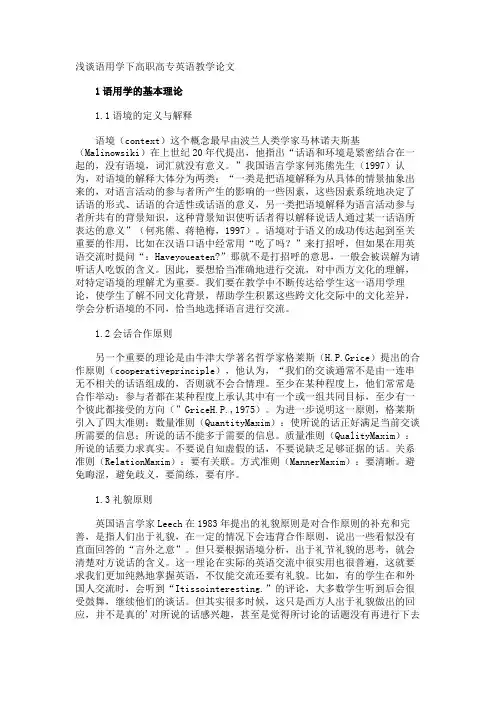
浅谈语用学下高职高专英语教学论文1语用学的基本理论1.1语境的定义与解释语境(context)这个概念最早由波兰人类学家马林诺夫斯基(Malinowsiki)在上世纪20年代提出,他指出“话语和环境是紧密结合在一起的,没有语境,词汇就没有意义。
”我国语言学家何兆熊先生(1997)认为,对语境的解释大体分为两类:“一类是把语境解释为从具体的情景抽象出来的,对语言活动的参与者所产生的影响的一些因素,这些因素系统地决定了话语的形式、话语的合适性或话语的意义,另一类把语境解释为语言活动参与者所共有的背景知识,这种背景知识使听话者得以解释说话人通过某一话语所表达的意义”(何兆熊、蒋艳梅,1997)。
语境对于语义的成功传达起到至关重要的作用,比如在汉语口语中经常用“吃了吗?”来打招呼,但如果在用英语交流时提问“:Haveyoueaten?”那就不是打招呼的意思,一般会被误解为请听话人吃饭的含义。
因此,要想恰当准确地进行交流,对中西方文化的理解,对特定语境的理解尤为重要。
我们要在教学中不断传达给学生这一语用学理论,使学生了解不同文化背景,帮助学生积累这些跨文化交际中的文化差异,学会分析语境的不同,恰当地选择语言进行交流。
1.2会话合作原则另一个重要的理论是由牛津大学著名哲学家格莱斯(H.P.Grice)提出的合作原则(cooperativeprinciple),他认为,“我们的交谈通常不是由一连串无不相关的话语组成的,否则就不会合情理。
至少在某种程度上,他们常常是合作举动;参与者都在某种程度上承认其中有一个或一组共同目标,至少有一个彼此都接受的方向(”GriceH.P.,1975)。
为进一步说明这一原则,格莱斯引入了四大准则:数量准则(QuantityMaxim):使所说的话正好满足当前交谈所需要的信息;所说的话不能多于需要的信息。
质量准则(QualityMaxim):所说的话要力求真实。
不要说自知虚假的话,不要说缺乏足够证据的话。
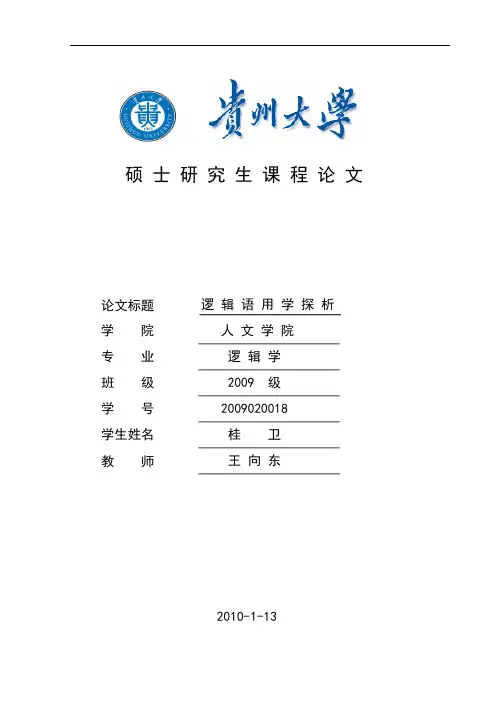
硕士研究生课程论文论文标题逻辑语用学探析学院人文学院专业逻辑学班级 2009 级学号 2009020018学生姓名桂卫教师王向东2010-1-13逻辑语用学探析摘要:本文在语用学的基础之上,简要介绍逻辑语用学的定义及研究逻辑语用学的哲学意义。
逻辑语用学不仅扩大了言语行为理论的研究领域,扩充了人们对语言表达意义的理解,而且还揭示出语言中所蕴含的理性——交往理性,进而拓展了生活世界理论研究的内容。
关键词:语用学、逻辑语用学、言语行为一:语用学简介语用学研究在不同语境中话语意义的前当地表达和准确地理解,寻找并确定使话语意义得以恰当地表达和准确地理解地基本原则和准则。
语用学于20世纪70年代于西方诞生,其是从研究符号与符号解释者的关系发展到不仅研究如何使用语言,还特别注重研究如何理解语言,研究如何从字面意义去理解其中的蕴含意义,成为一门新兴的认知学科。
语用学从说话人和听话人的角度,把人们使用语言的行为看作各种规约制约的社会行为,研究特定情景中的特定话语,从而发现语用规律。
它不是从语言系统内部(语音、语法、语义)去研究语言本身表达的意义,而是根据语境研究话语的真正含义,解释言下之意、弦外之音。
其研究的主要内容包括:语境、指示词语、会话含义、预设、言语行为、会话结构六个方面。
语用学研究语言的应用和理解,重在理解,重在语言的使用时,很注意语言的策略和场合要求向对方做出顺应,而在研究理解时十分注意交际的认知关系。
但在整个交际活动过程中,语用学既研究编码,也研究解码过程,更侧重于研究在不同的语言环境中如何理解和运用语言。
语用学的研究方法可分为三种不同的类型:①纯语用学:也叫形式语用学,是语言哲学领域的重要研究内容之一,他研究语用学的形式和范畴,是研究语用学形式化的最适宜方法。
②描写语用学:致力于描写人的来自经验的有关自然语言的运用原则,分析自然语言怎样跟语境相联系,关注人们为达到特定的交际意图在一定的语境中恰当地使用语言和准确地理解话语的语用能力。
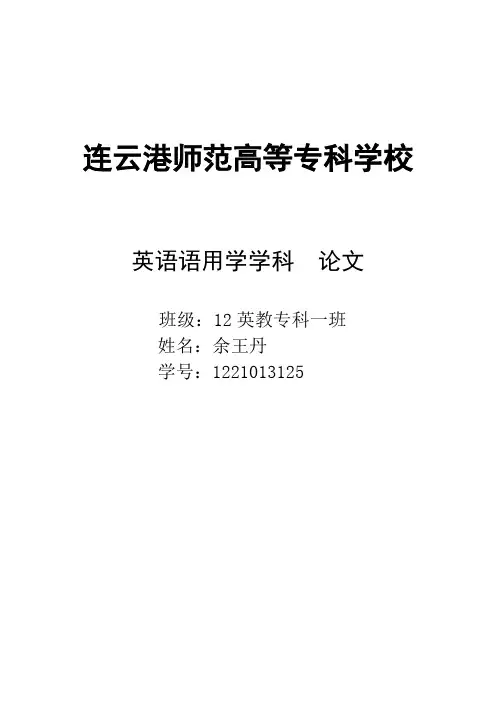
连云港师范高等专科学校英语语用学学科论文班级:12英教专科一班姓名:余王丹学号:1221013125摘要:本文主要从语用学的角度对语言交际中的礼貌现象进行了研讨,以旨更全面地展示语用礼貌观。
本文共分四部分:一、礼原则的由来;二、礼貌原则的解析;三、礼貌策略;四、礼貌原则的应用。
加深对礼貌原则的理解可以有助于提升自身的语用能力。
关键词:语用学礼貌原则教学应用一、礼貌原则的由来(一)礼貌的界定在众多关于礼貌的各种文献中,围绕“礼貌”一词进行的研究主要有五个方面,具体如下:(1)礼貌是人们在交际中的一种现实目的(Politeness as areal-world goa1)。
人们在说话过程中运用礼貌原则的目的就是取悦他人。
(2)礼貌是一种敬重(Politeness as the deference)。
(3)礼貌是一种语体(Politeness as the register)。
语体是指“与社交语境有关的系统化变体”(Lyons,1977)。
或者指在一定场合下人们说话或写作时的语言变化(Holliday,1978)。
(4)礼貌是一种话语表层现象(Politeness as an utterancelevel phenomenon)。
该观点认为,礼貌是一种表层语法编码,该观点主要是离开语言运用的实际环境去研究礼貌问题。
(5)礼貌是一种语用现象(Politeness as a pragmatic phi—nominee)。
该观点在语用学界已经成为人们的一种共识。
总之.在语用学领域,人们关心的不是说话人是否真正对他人友善,而是他说了什么,以及他的话语对听话人产生了什么影响。
把礼貌看成敬重、语体,是一种社会语言学现象,不属于语用学的范围,而把礼貌看成一种话语表层现象,就是脱离了语境去谈礼貌,这是一种超理想化的理论,因为语言形式是和语境、说话人和听话人之间的关系紧密联系的。
(二)礼貌原则提出的必要性在英语语用学习领域中,提及言语行为理论(Speech Act Theory).人们会很自然地联想到美国语言哲学家格赖斯(H.P.Grieve)的会话含义学说(Convocational Implicate),即为了保证会话的顺利进行,谈话双方必须共同遵守一些基本原则,尤其是用来解释会话结构的“合作原则”(Cooperative Principle)。
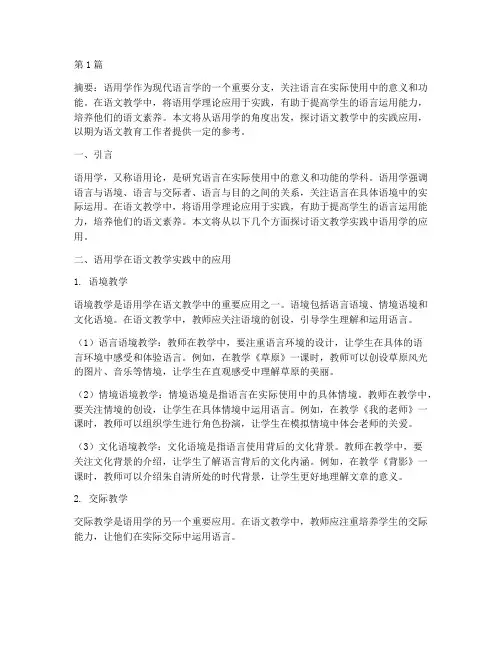
第1篇摘要:语用学作为现代语言学的一个重要分支,关注语言在实际使用中的意义和功能。
在语文教学中,将语用学理论应用于实践,有助于提高学生的语言运用能力,培养他们的语文素养。
本文将从语用学的角度出发,探讨语文教学中的实践应用,以期为语文教育工作者提供一定的参考。
一、引言语用学,又称语用论,是研究语言在实际使用中的意义和功能的学科。
语用学强调语言与语境、语言与交际者、语言与目的之间的关系,关注语言在具体语境中的实际运用。
在语文教学中,将语用学理论应用于实践,有助于提高学生的语言运用能力,培养他们的语文素养。
本文将从以下几个方面探讨语文教学实践中语用学的应用。
二、语用学在语文教学实践中的应用1. 语境教学语境教学是语用学在语文教学中的重要应用之一。
语境包括语言语境、情境语境和文化语境。
在语文教学中,教师应关注语境的创设,引导学生理解和运用语言。
(1)语言语境教学:教师在教学中,要注重语言环境的设计,让学生在具体的语言环境中感受和体验语言。
例如,在教学《草原》一课时,教师可以创设草原风光的图片、音乐等情境,让学生在直观感受中理解草原的美丽。
(2)情境语境教学:情境语境是指语言在实际使用中的具体情境。
教师在教学中,要关注情境的创设,让学生在具体情境中运用语言。
例如,在教学《我的老师》一课时,教师可以组织学生进行角色扮演,让学生在模拟情境中体会老师的关爱。
(3)文化语境教学:文化语境是指语言使用背后的文化背景。
教师在教学中,要关注文化背景的介绍,让学生了解语言背后的文化内涵。
例如,在教学《背影》一课时,教师可以介绍朱自清所处的时代背景,让学生更好地理解文章的意义。
2. 交际教学交际教学是语用学的另一个重要应用。
在语文教学中,教师应注重培养学生的交际能力,让他们在实际交际中运用语言。
(1)口语交际教学:教师在教学中,要关注口语交际能力的培养,让学生在日常生活中学会运用语言。
例如,在教学《自报家门》一课时,教师可以组织学生进行口语交际活动,让他们在交流中提高口语表达能力。
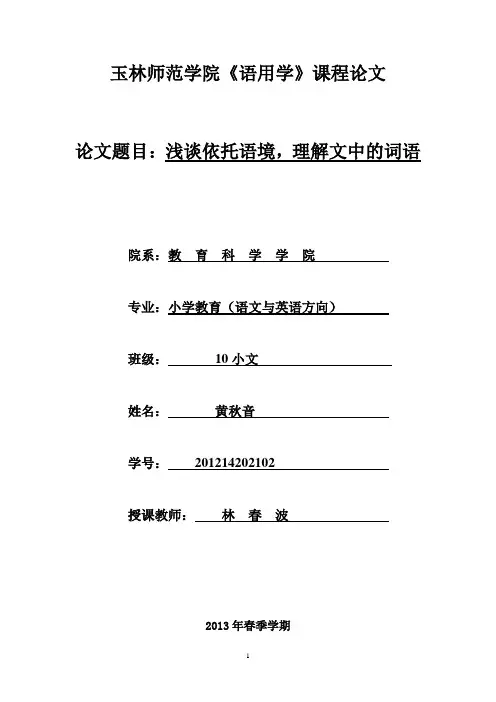
玉林师范学院《语用学》课程论文论文题目:浅谈依托语境,理解文中的词语院系:教育科学学院专业:小学教育(语文与英语方向)班级:10小文姓名:黄秋音学号:201214202102授课教师:林春波2013年春季学期浅谈依托语境,理解文中的词语摘要:语境在词语教学中具有不可替代的重要作用,创设语境,引导学生在具体的语境中触摸词语,体会词语意蕴,是优化词语教学的一种有效途径。
一般而言,主人公的思想就是文章精神实质的体现,而这些精神实质往往又体现在一些含蓄的语言情境中。
要准确地理解含蓄的语言,就必须联系主人公的形象、联系当下的时代背景。
一个关键词语,往往蕴含着复杂的思想内容,想更深层次的理解词语的含义,通过联系上下语句进行整体感知是必不可少的途径。
关键词:语境依托词语背景形象上下语句词语是构成文章的基本建筑材料, 准确而迅速地“理解文中重要词语的含义”是阅读的基础。
如果没有能够正确理解这些“重要词语”, 就无法准确地把握文意。
著名教育家苏霍姆林斯基说过:“理解词语是理解句子的基础,但理解词语不能离开具体的语言环境,只有以具体的语境为依托,词语才有肥沃的土壤,理解词义才会水到渠成。
”自从新课标把培养学生“有较丰富的积累和良好的语感,注重情感体验,发展感受和理解的能力”列入阅读能力要求之后,语境与语感教学引起了语文教师的广泛重视。
那么如何让帮助学生提高在语境中理解语言的能力呢?一篇文章就是一个具体的场合,其因素有:上下语句、主人公的形象、插图、时代背景及作者身世。
下面将从以上几个因素来理解语言的深层含义。
一、通过上下语句的联系理解词语汉语的词与词之间没有明确的形态变化的标记,一个词、一句话、一段话,孤立地看,不一定有意义。
因此,词语的理解必须根据行文的上下文所提供的线索来展开。
教师在指导学生时,要注意找到理论联系实际的切入点,通过选择典型的语文材料,进行反复训练,帮助学生逐步养成联系上下文分析语句、语段的良好的习惯,培养起对上下文的敏感。
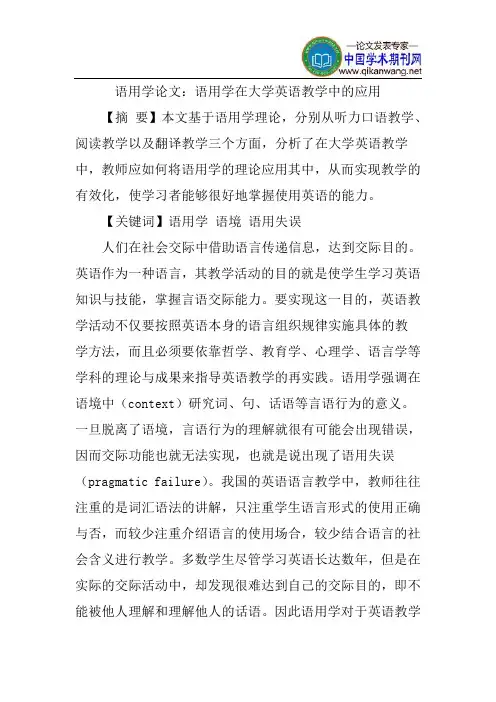
语用学论文:语用学在大学英语教学中的应用【摘要】本文基于语用学理论,分别从听力口语教学、阅读教学以及翻译教学三个方面,分析了在大学英语教学中,教师应如何将语用学的理论应用其中,从而实现教学的有效化,使学习者能够很好地掌握使用英语的能力。
【关键词】语用学语境语用失误人们在社会交际中借助语言传递信息,达到交际目的。
英语作为一种语言,其教学活动的目的就是使学生学习英语知识与技能,掌握言语交际能力。
要实现这一目的,英语教学活动不仅要按照英语本身的语言组织规律实施具体的教学方法,而且必须要依靠哲学、教育学、心理学、语言学等学科的理论与成果来指导英语教学的再实践。
语用学强调在语境中(context)研究词、句、话语等言语行为的意义。
一旦脱离了语境,言语行为的理解就很有可能会出现错误,因而交际功能也就无法实现,也就是说出现了语用失误(pragmatic failure)。
我国的英语语言教学中,教师往往注重的是词汇语法的讲解,只注重学生语言形式的使用正确与否,而较少注重介绍语言的使用场合,较少结合语言的社会含义进行教学。
多数学生尽管学习英语长达数年,但是在实际的交际活动中,却发现很难达到自己的交际目的,即不能被他人理解和理解他人的话语。
因此语用学对于英语教学的影响值得我们进一步探究。
一语用学的定义虽然目前语言学界对于语用学的定义和范畴还没有统一的见解,但语言学家都有一个共识,即语境是语言学的核心概念之一,是一门专门研究语境在交际过程中的作用的学科。
人们的正常语言交流总离不开特定的语境。
这里的语境包括交际的场合(时间、地点等)、交际的话题、交际的参与者以及上下文。
人们要判断一句话的意思,应当结合具体的语境,推断出它的真实含义。
离开了语境,也就失去了依据,在交流中有时难免会产生困惑甚至误解。
二听力口语教学方面将听力口语教学置于教学首位完全遵循了语言学习的规律。
教师在组织这方面学习的过程中,应刻意引入语用学的知识,结合交际语境,介绍日常交际话语的语用意义。
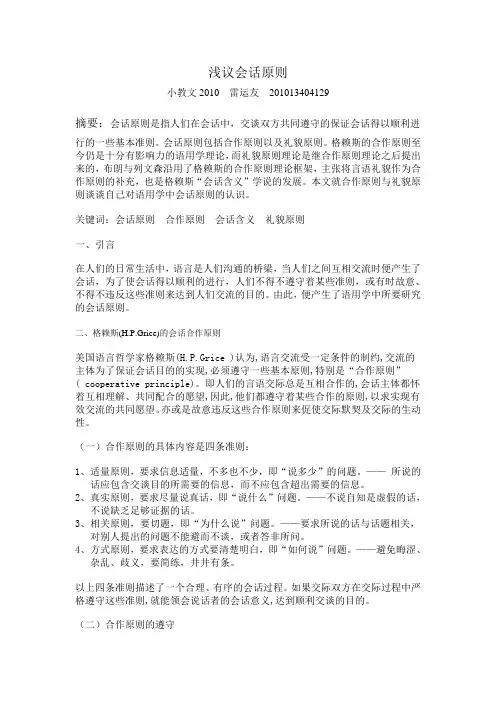
浅议会话原则小教文2010 雷运友201013404129摘要:会话原则是指人们在会话中,交谈双方共同遵守的保证会话得以顺利进行的一些基本准则。
会话原则包括合作原则以及礼貌原则。
格赖斯的合作原则至今仍是十分有影响力的语用学理论,而礼貌原则理论是继合作原则理论之后提出来的,布朗与列文森沿用了格赖斯的合作原则理论框架,主张将言语礼貌作为合作原则的补充,也是格赖斯“会话含义”学说的发展。
本文就合作原则与礼貌原则谈谈自己对语用学中会话原则的认识。
关键词:会话原则合作原则会话含义礼貌原则一、引言在人们的日常生活中,语言是人们沟通的桥梁,当人们之间互相交流时便产生了会话,为了使会话得以顺利的进行,人们不得不遵守着某些准则,或有时故意、不得不违反这些准则来达到人们交流的目的。
由此,便产生了语用学中所要研究的会话原则。
二、格赖斯(H.P.Grice)的会话合作原则美国语言哲学家格赖斯(H.P.Grice )认为,语言交流受一定条件的制约,交流的主体为了保证会话目的的实现,必须遵守一些基本原则,特别是“合作原则”( cooperative principle)。
即人们的言语交际总是互相合作的,会话主体都怀着互相理解、共同配合的愿望,因此,他们都遵守着某些合作的原则,以求实现有效交流的共同愿望。
亦或是故意违反这些合作原则来促使交际默契及交际的生动性。
(一)合作原则的具体内容是四条准则:1、适量原则,要求信息适量,不多也不少,即“说多少”的问题。
——所说的话应包含交谈目的所需要的信息,而不应包含超出需要的信息。
2、真实原则,要求尽量说真话,即“说什么”问题。
——不说自知是虚假的话,不说缺乏足够证据的话。
3、相关原则,要切题,即“为什么说”问题。
——要求所说的话与话题相关,对别人提出的问题不能避而不谈,或者答非所问。
4、方式原则,要求表达的方式要清楚明白,即“如何说”问题。
——避免晦涩、杂乱、歧义,要简练,井井有条。
以上四条准则描述了一个合理、有序的会话过程。
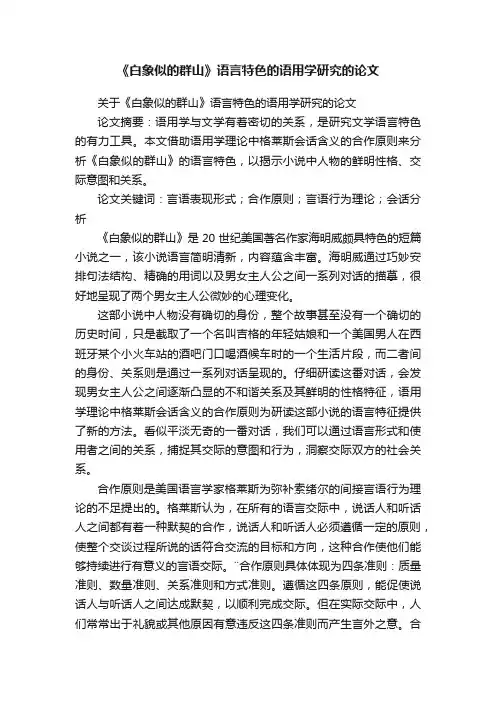
《白象似的群山》语言特色的语用学研究的论文关于《白象似的群山》语言特色的语用学研究的论文论文摘要:语用学与文学有着密切的关系,是研究文学语言特色的有力工具。
本文借助语用学理论中格莱斯会话含义的合作原则来分析《白象似的群山》的语言特色,以揭示小说中人物的鲜明性格、交际意图和关系。
论文关键词:言语表现形式;合作原则;言语行为理论;会话分析《白象似的群山》是20世纪美国著名作家海明威颇具特色的短篇小说之一,该小说语言简明清新,内容蕴含丰富。
海明威通过巧妙安排句法结构、精确的用词以及男女主人公之间一系列对话的描摹,很好地呈现了两个男女主人公微妙的心理变化。
这部小说中人物没有确切的身份,整个故事甚至没有一个确切的历史时间,只是截取了一个名叫吉格的年轻姑娘和一个美国男人在西班牙某个小火车站的酒吧门口喝酒候车时的一个生活片段,而二者间的身份、关系则是通过一系列对话呈现的。
仔细研读这番对话,会发现男女主人公之间逐渐凸显的不和谐关系及其鲜明的性格特征,语用学理论中格莱斯会话含义的合作原则为研读这部小说的语言特征提供了新的方法。
看似平淡无奇的一番对话,我们可以通过语言形式和使用者之间的关系,捕捉其交际的意图和行为,洞察交际双方的社会关系。
合作原则是美国语言学家格莱斯为弥补索绪尔的间接言语行为理论的不足提出的。
格莱斯认为,在所有的语言交际中,说话人和听话人之间都有着一种默契的合作,说话人和听话人必须遵循一定的原则,使整个交谈过程所说的话符合交流的目标和方向,这种合作使他们能够持续进行有意义的言语交际。
¨合作原则具体体现为四条准则:质量准则、数量准则、关系准则和方式准则。
遵循这四条原则,能促使说话人与听话人之间达成默契,以顺利完成交际。
但在实际交际中,人们常常出于礼貌或其他原因有意违反这四条准则而产生言外之意。
合作原则为我们赏析小说中的对话提供了新的方法。
小说《白象似的群山》中违反合作原则次准则产生的言外行为较为丰富。
语言学论文-语用学Comparison between Chinese and EnglishIdiomsAbstract: Idioms exist in both Chinese and English, and they have been used frequently for a long time. Furthermore, idioms are fixed phrases extracted from language over long time of usage. Although they are formed in short phrases, for example idioms known as “成语” in Chinese, which has only four or eight letters, their meanings are exuberant and connotative. Therefore, the analysis of the idiom’s usage and the cultural differences it reflects is significant to every language learner and translator.Key words: idiom; culture;comparison; differences1 Theoretical Foundation of the Idiom1.1 Definitions of Chinese IdiomsAccording to “Modern Chinese Dictionary”, “Cheng yu”is fixed phrases or short sentences which are concise, having been accepted by common people through years of usage.According to “Cihai”, “Shuyu”(Idiom) is fixed phrases or sentences of a language, which cannot be modified arbitrarily. It must be interpreted as a semantic unit. It includes set phrases, proverbs, maxims, locutions and two-part allegorical sayings, etc.1.2 Definitions of English Idioms“Longman Dictionary of English Language and Culture”has two definitions of idiom: (1) a phrase which means something different from the meaning of the separate words from which it is formed; (2) the way of expression typical of a person or a group in their use of language (Summers P., 1998: 657).“Th e New Oxford English Dictionary”defines that idiom is:(1) a group of words established by usage as having a meaning not deducible from those of the individual words; (2) a form of expression natural to a language, person, or a group of people (Pearsall J, 2001:908).1.3 The Rhetoric of IdiomsIdiom is the distillate of the nation language abstracted bypeople during a long practice. There are three main features of idiom rhetoric: abundant comparisons, vivid words and lively contrasts.First, simile is a direct comparison, in which subject, reference and indicator of resemblance are all present. Such as the Chinese idiom “轻如鸿毛” and the English idiom “as light as a feather”.Second, metaphor—use of a word or phrase to indicate something different from the literal meaning. For example, the Chinese idiom “口若悬河”,it doesn’t mean the river hang on the mouth, but means someone who speaks eloquently and volubly.Third, metonymy—means correspondence or partial similarity between two things that are compared. For instance, “犬马之劳”means to sever somebody faithfully like the dog or the horse. “be in the pipeline”means that if a plan is in the pipeline, it is being developed and will happen in the future.Fourth, analogy is to compare two things or people so that differences are made clear. “口蜜腹剑”literally means someone is honey-mouthed but dagger-hearted. That is to say the person is treacherous and hypocritical. “To bite the hand that feeds one”also uses the contrast. It means to treat someone badly who has helped you in some way.F ifth, exaggeration such as “垂涎三尺” exaggerated means a drool with great envy. “A stream of tears”means someone is really heart-broken.is revealed, like the denotative meaning of words, especially for those culturally-loaded words like idioms. Idioms have a close relationship with the culture to which it is attached that they truly reflect the values and philosophy of life of the people in that culture and are rich in cultural connotations.Comprehension of the Exotic IdiomsThere are some exotic idioms in the Chinese idioms. Such as “以眼还眼”comes from the English idiom “an eye for an eye”. This idiom which comes from the Bible means that if someone does something wrong, they should be punished by having the same thing done to them. And another Chinese idiom “诺亚方舟”, “Noah’s ark” also comes from the Bible.The English idiom “An Achilles’heel” means a small fault in a person or system which might cause them to fail. This idiom is from Greek mythology. Achilles was a man who was killed when he was injured on his heel, because this was the only part of his body where he could be harmed.Therefore, idioms can be an effective tool of learning culture. And learning culture items like idioms can be one of the good examples to learn both language and culture simultaneously. Learning idioms can also make us learn more about the knowledge of cultural background.2 Compare Chinese Idioms with English Idioms2.1 Similarities between Chinese and English IdiomsAs human civilization has developed in a similar way, both English and Chinese idioms are similar in basic moral concepts and value viewpoint, which has formed a common base for both cultures. Their similarities are as follows: First, in both English and Chinese we have alike idioms to express the hard-working, brave and indomitable human nature and the good will and forgiveness. Also there are many idioms in both languages to praise the pi oneering spirit. For example, “既往不咎, Let bygones be bygones”, “心安理得, Have peace of mind”, “有志者,事竟成, Where there is a will, there is a way”, “有始有终, From beginning to end”, etc. Second, those idioms in both English and Chinese to expr ess verities are same. Such as “眼见为实, Seeing is Believing”,etc. Third, the same imagination in both English and Chinese has the same comparison in the idiom. For instance, “轻如鸿毛, As light as a feather”, “冰清玉洁, Be as clear as crystal”, etc.The above similarities are essential to the intercultural communication. Different cultures may conflict in many aspects, but must agree on basic morals and value points. Only by agreeing on basic morals and value points, can cultural conflicts be limited in a tolerable level and intercultural communication carried out.2.2 Differences between Chinese and English Idioms2.2.1 Differences in Animal-related IdiomsAnimals are friends of human. They have so many links withhuman beings and human languages. Before the arrival of modern civilization, sometimes even today, the basic necessities in human life such as food, clothing and transportation and so on are obtained directly or indirectly from various animals. Among all kinds of animals, dogs are particularly valuable in protecting property, finding things and hunting quarries. Pigeons have long been used to deliver messages. Of course, some animals can also do harmful things to human beings, such as wolf, mice, etc., but no matter what they do, whether good or bad, animals are closely related with the daily life of human beings including everyday speech and animal-related idioms are come into being.Dog in most of the English idiom symbolizes the lay folk as “guy”. There is no d erogatory sense in it, such as “a lucky dog 幸运儿”, “love me, love my dog 爱屋及乌”, “help a lame dog over a stile 助人渡过难关”, etc. Of course, there is a little derogatory sense of dog used in idioms to describe the useless, woeful thing. For example, “ a dog in the manager 占着位子不做实事”, “ lead a dog’s life 过着可悲的生活”, etc. On the contrary, in Chinese idiom dog is used to describe beggarliness. Therefore, most of the dog related Chinese idiom is derogatory, like “狗急跳墙—a cornered be ast will do something desperate”, “狗尾续貂—a wretched seq uel to a fine work, incongruous”, “蝇营狗苟—shamelessly seek personal gain”, and others like “狗血喷头,狗仗人势,狗咬狗” etc.Differences in Color-related IdiomsThere are many idioms related to color both in Chinese and English, such as black (黑) and white (白); Black actually is the complete absorption of all light, while white is opposite to black. Therefore, in idioms Black and White also stand on two extreme points. As the original meaning of the black and white, they have the same expression in both Chinese and English idioms, such as “black and white 黑白分明”, “in black and white 白纸黑字”, “turn black into white 颠倒黑白”, etc. But there are some differences in their transferred meaning.In English idiom, black is used to describe atrocity, death and ominous thing, l ike “black sheep 害群之马”, “a black day 不吉利的日子”, etc. But sometime black also has a commendatory usage, such as “a business in the black 盈利的事业”. White in English idiom means chastity, integrity and elegance, for instance “a white lie 善意的谎言”, “the white day 良辰吉日”, and they have the “ white wedding”.In Chinese idiom, black is only used to describe incorrect, bad and criminal thing, for example, “心黑手狠—heartless and cruel”, etc. White in Chinese idiom is unlike its using in English idiom. It represents dreariness, poor and bereavement, for example, “白手起家—start something from scratch”, “一穷二白—poor and blank”, “红白喜事—wedding and bereavement”, etc.(潘红, 2005:209)Differences in Numeral-related IdiomsNumber, as an important part of language, is embodied withdifferent cultural background. Idioms with numbers are the central core and cream of languages, reflecting the wisdom of human kind. They have strong ethnical, historical and regional colors, reflecting the culture difference of different nationalities.To analysis numbers in both Chinese and English idioms, I find that the substantive meaning of number in both Chinese and English idioms is same. For example, “一心一意—whole-heartedly”, “one thing leads to another—一环扣一环”. Furthermore, in English idioms most of the numbers, except the number three and seven, are used as a substantive. It’s the biggest difference between Chinese and English numeral-related idiom. Because expect the substantive meaning of numbers in Chinese idiom, there are many abstractive meaning of numbers used in Chinese. First, the abstractive meaning of number in Chinese always expresses “more”or “less”. For example, one, half and “寸” are used to express “less”, like “一无所长—have no special skill”, “手无寸铁—unarmed”, etc. While three, five, six and nine are used to express “more”, nothing to say hundred and thousand, such as “三头六臂,三令五申,成百上千”, etc. Second, the numb er ten and one sometimes means “whole or all”, such as “十全十美—be perfect in every way”, “一如既往—just as in the past”. Third, two numbers in the same idiom usually express a transformation or a proportion, such as “三长两短—unforeseen accidents”, “十拿九稳—be very sure of success”, “百无一是—have no merits at all”. Fourth, some idioms arecustomarily be used, such as “一退六二五—deny all responsibility”and “不管三七二十一—regardless of the consequences”.(吕叔湘, 2002: 198) They are come from the custom of the counting frame which we used in ancient for counting numbers.In summary, from what is discussed above, we know that numbers play important roles in human cultures. They have strong connotations in both English and Chinese cultures.2.2.4 Differences in Mythology-related IdiomsThere are numerous idioms related to myths in English and Chinese. In English idioms, idioms of mythical origins are mainly from Greek and Roman mythology, which originating from their worship of the nature by Greek and Roman ancestors. Similarly, in Chinese idioms, mythology is generally of Chinese origin. These idioms reflect the formation of Chinese Culture in the primitive stage. They show a full scope of primitive recognition of the world.Take “dragon 龙”for example, dragon is a frequenter in both Chinese and English Myths, so there are many mythical idioms related to dragon. However, the associated meaning of dragon and 龙are opposite. In English, dragon connotes “a terrible fire-breathing monster”or “a giant that eats man”. According the famous legend “Beowulf”, a dragon that had three heads and could breathe fire guarded treasure for the “devils”. So dragon is always associated with devil. In the medieval times,“dragon”was associated with “sin”and it was the symbol of “heresy”. Nowadays, there is the idiom “chase the dragon—means take drugs”, so we can see how evil the dragon is in the westerners’ view.The opposite associated meaning of dragon in Chinese is always a commendatory. First, we see dragon is the totem of the Chinese people. We call ourselves the descendants of dragon proudly, such as “龙的传人”and “龙子龙孙”. Second, dragon in Chinese is associated with “emperor”, because emperors always name themselves as “真龙天子—the god’s son not the devil’s”. Third, dragon is associat e with “talent”, such as the id iom “龙生龙子,虎生豹儿—means talented perso n’s descen dants must be prominent”. Fourth, dragon is also associated with "good luck and success", such as “龙凤呈祥—means good luck”, and “望子成龙—means people hope their children can get success”, etc.3: ConclusionThrough the comparison between Chinese and English Idioms, their differences and similarities are obvious. This is meaningful and helpful for every language learners and users.References:[1] Alfred Lord Tennyson. Poems [M].Cambridge Press.2001.[2] Nida nguage,culture and translation [M].ShanghaiForeign Language Education Press,2000.[3]Pearsall J. The New Oxford English Dictionary [M].Oxford University Press,2001.[4] Summers P. Longman Dictionary of English Language andCulture[M].Longman Press,1998.[5] 辞海编辑委员会.辞海[M].北京:商务印书馆,1989.[6] 胡文仲.英美文化辞典[M].上海:外语教学与研究出版社, 1995.[7] 李娅玲.英语成语中色彩词汇的文化特征[J].怀化师专学报,1999(12).[8] 吕叔湘.现代汉语大辞典[M].北京:商务印书馆,2002.[9] 潘红.英汉国俗词语例话[M].上海:上海外语教育出版社, 2005.。
Pragmatic Vagueness in Verbal CommunicationAbstract:Pragmatic vagueness is a common phenomenon in verbal communication. Combined with the existing achievements, the thesis attempts to analyze the phenomenon of pragmatic vagueness, pragmatic vagueness as a strategy in verbal communication and its pragmatic functions in verbal communication from the perspectives of cognitive pragmatics and sociolinguistics, in English examples, in order to prove the necessity of pragmatic vagueness as a communicative strategy. That is, for its pragmatic functions, the communicators make widely use of pragmatic vagueness in order to realize their communicative intentions and achieve successful communication.Key words: pragmatic vagueness, pragmatic functions ,strategyⅠ. IntroductionAs the research on pragmatics is deepened, many scholars conducted research on pragmatic vagueness. Pragmatic vagueness is an important pragmatic strategy. The research on pragmatic vagueness in verbal language is intriguing, realistic and useful. Verbal language is not only useful for its parishioners but also for English learners.In daily communication, people sometimes use precise language to express their ideas, but more often people prefer to use vague language to convey information. Vagueness is completely intrinsic in human language and the frequent use of hedges just fully testifies this inborn nature of language. The use of hedges is a common phenomenon in language communication. Therefore, the appropriate use of hedges in interaction can enhance the expressive force and communicative effect of language, making the expressions more natural, decent, polite, flexible, and effective. Moreover, the right use of hedg es can send people’s emotion and ideas more properly thereby helps to maintain a good interpersonal relationship between the two parties in communication and achieve the communicative goal successfully.Ⅱ. Pragmatic VaguenessCommunication falls into three categories in terms of conversational analysis: literal talk, loose talk and metaphorical talk. Indeed, most people’s conversation in daily life is loose in verbal communication, to some extent, carrying approximation,fuzziness, generality, ambiguity, ambivalence. In addition, daily conversation usually carries connotative expression such as metaphor, meiosis, irony and hyperbole. (He Ziran, 2000:8) The peripherical meaning or range error manifested in pragmatics is called generality or vagueness. (He Ziran, 1990:8) From what these scholars discussed above, we know that pragmatic vagueness in communication is very important.(a)Being a strategy of communication, pragmatic vagueness relies on various linguistic structures to realize its functions. Thus, the addressor needs to manipulate her language so as to choose a proper linguistic structure which can carry out her strategy. Through careful observation of the data, we generalize three ways of linguistic manipulation involved in the strategy of pragmatic vagueness, namely, enhancing the context-dependency of the utterance, broadening the interpretative range of the utterance, widening the distance between the idea and its way of expression. Furthermore, some specific linguistic devices are included in each category. Thus, the variability of pragmatic vagueness is demonstrated through its ways of linguistic manipulation.Ⅲ.Pragmatic Vagueness as a Strategy in Verbal CommunicationAs we all know, verbal communicative activities requires linguistic technique and diction of words. Due to different ideology and value, there are always different views on the same issue which is a common phenomenon. Therefore, verbal language is a vital strategy to achieve success in communicative activities.Vagueness is a traditionally focused topic of the study of epistemic theory as well as semantic theory about which there have appeared a large quantity of articles, and among which semantic factors are highly involved and consequently cognitive factors are seldom taken into account. Couched within Sperber and Wilson’s (1986/1995) Relevance Theory, the thesis makes the claim that pragmatic vagueness is a linguistic choice and a communicative strategy chosen by interlocutors to achieve optimal relevance.(b) The author, based on the relevant discussions on vagueness at home and abroad in recent years, makes a systematic analysis of pragmatic vagueness in the new light of cognitive pragmatics with passing comments on the limitations of the explanations provided by epistemic theory,semantic theory, speech act theory and Co-operative Principle. Linguistic devices at different levels such as phonology, lexicon, rhetoric and speech act work as pragmatic vagueness triggers to facilitate the search for optimal relevance. The conclusion is that pragmatic vagueness conforms to the Principle of Relevance in that it can achieve the greatest cognitive effects with the least processing efforts. The communicative functions of pragmatic vagueness include giving right amount of information, expressing the addresser’s propositional attitude, manipulating the focus of the addressee’s attention and achieving humorous and polite effects. Appropriate use of pragmatic vagueness as a communicative strategy is of positive significance to the development of learners’pragmatic competence and the avoidance of pragmatic failure.IV. Communicative functions of vaguenessLanguage is for communication, whereas vagueness may lead to better communication. Using vagueness can avoid being presumptuous in language communication. When we have to touch some topics that are unpleasant, we tend to choose more vagueness expressions to refer to those painful topics so as not to hurt the hearer’s fee ling. We can find the theoretical foundation for this motivation in Leech’s Politeness Principle. Vagueness just minimize the impoliteness and maximize the politeness in communication. The functions of vagueness are in agreement with those of Politeness Principle too, as they both offer more benefit to the hearer and leave more cost to the speaker, with the purpose that both of the two sides will feel respected and have favorable impression of each other. As politeness is usually regarded as the manifestation of human civilization, euphemism is one of the most effective strategies to display politeness while modulating interpersonal relationship in human communication.SubstitutionAccording to the definitions of vagueness and we know that a great number of English vagueness serve as the substitutions for verbal taboos. The term taboo ( ta meaning “mark”, boo meaning “exceedingly”) of Polynesian origin denotes anything linguistic and nonlinguistic, which is prohibited or forbidden.(c) Taboo refers to the situation in which a word or name can be used in a community only under special conditions, whether only by certain persons or only in certain circumstances. Just as violating a cultural taboo can be quite offensive, so is it with a verbal taboo in pressc onferences. The “word” has been and continues to be in most societies perceived as a powerful instrument that may evoke evil spirits, make bad things happen and instigate to violence and revolution and numerous other activities. While taboo of words occurs when a particular topic is considered valid for discussion, vagueness expression or terms are required. Diplomatic vagueness has a very serious reason for being. They can conceal the things people fear most —death, the dead or the supernatural. Euphemisms can also eliminate unhappiness, embarrassment and fear etc. so as to relieve people psychologically.PolitenessPoliteness is another very important function that vagueness serve in social life. “Some of the vagueness is used to avoid crudeness and indecency for the sake of a polite conversation”. (d) Grice formulated Cooperative Principle of utterance in which the Maxim of Manner was defined as “Be perspicuous and specific; To avoid obscurity; To avoid ambiguity; To be brief and to be order ly.”(e)The roundabout nature of vagueness goes against the Maxim of Manner, which can only be fairly explained well by Leech’s Politeness Principle “Approbation Maxim: minimize dispraise of other, maximize praise of other”. (f) In other words, euphemisms are to minimize impolite expressions and maximize polite expressions.DisguiseBesides the two functions of vagueness mentioned above, there is still another one more important function at work in vagueness communication, namely, the Disguise Function. Here we mean that because of the vagueness of, vagueness it has become a very important tool for political leaders or the diplomats or statesmen to distort the facts or and present a false picture of peace and prosperity and to beautify whatever the authority have do ne. For example, in the Iraq War, they use “Operation Iraqi Freedom” for beautifying their military invasion, “possible movement” refers to military attack, “air operation” or “air strikes” for air attack, “enter the war” to show their reluctance to fight the war etc.(g) and we may find many such kind of these vagueness in press conferences. The most important and ultimate function or purpose of the use of diplomatic vagueness in press conferences is to disguise or beautify their invasive essence or other evil actions or the separation of words from truth. In American and British societies nowadays, diplomatic vagueness are always purposely devised to disguise scandals in wars and politics, deliberately invented to beautify lowly occupations and excessively inflated to promote sales in advertisement.V. ConclusionAs we stated earlier, vagueness is one of the important and universal linguistic phenomena. Due to the special characteristics like substitution, indirectness etc. it is becoming one of the main communicative approaches. The thesis has attempted to study the vagueness expressions used in the question-answer patterns from the perspective of pragmatics.The article is an overview of the functions and communicative functions of vagueness, and from the pragmatic analysis of the materials, it can be seen clearly that the use of vagueness basically violate the Quality Maxim, the Quantity Maxim, and the Manner Maxim of the Cooperative Principle and the frequency of violating the Quality Maxim is the highest among the three ones. That is to say, the vagueness used in the question-answer patterns generally does not violate the Relation Maxim of the Cooperative Principle.There is an old saying in English: Necessity is the mother of invention. The creation of vagueness also cannot depart from people’s needs of them. People need vagueness for social communication, to vagueness the taboo, to show their politeness and to disguise. As a sociolinguistic phenomenon, the formation of vagueness is the result of the combination of various social psychological factors and pragmatic factors.Studies on vagueness from a pragmatic perspective reveal how vagueness flout the Cooperative Principle so as to obey the Politeness Principle in communication and how factors from their socio cultural and communicational context influence their application in communication. Any change of one or more factors of a communication event, will have an effect on our decision of whether to use vagueness. The expressive vagueness plays a non-fungible role in communication. It is vagueness that makes language more powerful, magical and pleasant. People’s speech does reflect their background, their activities, and the values they hold, therefore, we can learn much about the English people by looking at their use of vagueness. The studies on English vagueness can not only help to develop intercultural communicative competence, but also enlighten English language learning and teaching. Therefore, multidisciplinary, multi-angle, and multi-level studies on vagueness are necessary for English learners to understand the English history and society and communicate with native English speakers better. There are still a lot in this field waiting to be explored, and vagueness deserve more attention and comprehensive studies.References:1.Brown, P and Levinson,S.1978. “Universals in language Usage: Politeness Phenomena”. In Goody, E, N. (ed.): Questions and Politeness. Cambridge: Cambridge University Press. 56-310.2.Channell, J. 1994 Vague Language. Oxford: Oxford University Press.3.Ellis, R. 1985. Understanding Second Language Acquisition. Oxford: Oxford University Press.4.Grice, H. P. (1975). Logic and conversation. In Cole, P&Morgan, J, L, (eds,) Syntax and Semantics, V ol, 3: Speech Acts. New York: Academic Press.5.Hubler, A. 1983. Understatements and Hedges in English. Amsterdam and Philadelphia, PA:John Benjamins. /koff, G. 1972. “Hedges: A Stu dy in Meaning Criteria and the Logic of Fuzzy Concepts”. Papers from the Eighth Regional Meeting of the Chicago Linguistic Society 1972. 183—228 Reprinted in: Journal of Philosophical Logic. 1973.4: 2.458—508.Corpus(a) Daily conversation usually carries connotative expression such as metaphor, meiosis, irony and hyperbole. (He Ziran, 2000:8) The peripherical meaning or range error manifested in pragmatics is called generality or vagueness. (He Ziran, 1990:8) (b) Cou ched within Sperber and Wilson’s (1986/1995) Relevance Theory, the thesis makes the claim that pragmatic vagueness is a linguistic choice and a communicative strategy chosen by interlocutors to achieve optimal relevance.(c) The term taboo ( ta meaning “mark”, boo meaning “exceedingly”) of Polynesian origin denotes anything linguistic and nonlinguistic, which is prohibited or forbidden.(d)Some of the vagueness is used to avoid crudeness and indecency for the sake of a polite conversation.(e) Be perspicuous and specific; To avoid obscurity; To avoid ambiguity; To be brief and to be orderly.(f) Approbation Maxim: minimize dispraise of other, maximize praise of other.(g) I n the Iraq War, they use “Operation Iraqi Freedom” for beautifying their military inva sion, “possible movement” refers to military attack, “air operation” or “air strikes” for air attack, “enter the war” to show their reluctance to fight the war etc.。
这是一个文明的社会,人类拥有一门充满魅力和艺术的技能——语言。
语言是人与人交流中不可缺少的重要工具。
在我们的衣食住行中,没有一样是可以离开语言的沟通与表达的,从而语言成为一门技巧。
语言可以传递信息,可以交流感情,掌握良好的语言技巧,我们可以抒发我们的感情,可以赢得良好的人际关系,可以得到别人的理解和尊重……从而语言成为一门学问。
正确恰当的语言交际中,应该遵守“合作原则”,“礼貌原则”这两大原则,遵循四条准则,即:量准则、质准则、关系准则、方式准则。
在此,我想浅谈一下“礼貌原则”。
什么是礼貌?礼貌通常被理解为说话人为了达到某一目的,如增加或维护交际双方的和睦关系而采取的措施。
表达礼貌的主要手段之一就是语言的运用。
语言学家Leech提出礼貌原则的六大准则,包括得体准则,慷慨准则,赞扬准则,谦逊准则,一致准则,同情准则。
所谓得体准则,就是要求我们交流时少让别人吃亏,多让别人得益。
交流时,应以说话人身份为出发点,注重交流对象,注意场合。
很亲近的同学、朋友间聊天可以是“臭小子,你怎么不来看我”、“二货,你怎么这么傻啊”,但是若对于长辈或上司,应表现出敬重,如“王主任,早上好!”、“韩教授,久仰大名啊!”同学聚会、好友闲谈时可以开玩笑、调侃。
若在会议等正式场合一定要注意措辞。
慷慨准则就是让我们尽量少让自己得意,多让自己吃亏。
适当的时候,跟人交谈,多开开玩笑自嘲一下自己,会让自己更具有亲和力,更容易被人接受。
同样的表达两个没有可比性,“你怎么能跟我比?”和“我怎么能跟你比?”所包含的感情色彩完全不同,后者是把对方捧上一个台阶,而前者相反。
每个人都希望得到赞扬,“你的衣服真漂亮!”“好久不见,越来越年轻了。
”“你家儿子真聪明。
”简单的一句赞美,却能让人心头甜蜜,促进人际关系。
学会发现美,发现别人优点,懂得赞美别人。
可以说中国人是向来很谦虚,中国传统文化正可以体现出“谦逊准则”,我们称自己为“鄙人”“在下”,称自己的妻子“贱内”,称自己的儿子“犬子”,而对别人,则是“尊姓大名”,“令堂身体可好”“您老贵庚”我们都希望被人接受和认可,受到他人尊重,一致准则要求我们尽量减少分歧,增加一致。
指示语是语用学研究的一个重要方面,它主要研究如何运用语言形式表示语境特征以及如何依靠语境来分析理解话语,它是语言和语境之间关系最明显、最直接的语言反映。
指示语一般分为五类,即人称指示、时间指示、地点指示、语篇指示和社交指示。
人称指示语是指对编码于言语活动中的参与者或相关角色的符号指称,它般可分为三类:第一人称指示,包括说话人;第二人称指示,包括听话人;第三人称指示,既不包括说话人,也不包括听话人。
一般来讲,人称指示语在使用中严格遵守其语法准则,有着人称数量和性质的区别:即第一人称指代说话人,第二人称指代听话人,第三人称指代二者以外的人.例如(1)我是北方人。
(2)你是南方人。
(3)他走了。
例(1)—(3)中的“我”、“你”、“他”分别指代说话人、听话人和二者以外的人。
我们把这种严格遵守人称指示语的分类,并且与现实所指目标之间有着严格的对应关系的用法,称作人称指示语的常规用法第一人称指示一、第一人称的常规用法汉语中第一人称指示语主要有我/咱、我们/咱们,咱/咱们多用于口语中.例如(4)我喜爱古典音乐,(5)我们是外语学院的。
在例子(4)、(5)中“我”、“我们”指的就是言语行为的说话者本人。
二、第一人称的非常规用法1、第一人称单数指代第一人称复数(6)我校于上星期圆满举办了校运会。
(7)咱家可漂亮了。
(8)还我青岛,还我河山。
例子(6)中的“我”是表达“我们”的意思,我们学校与上星期圆满举办了校运会,个人代表集体。
例(7)“咱”是表示“咱们”,包括听话者,拉近彼此之间的距离。
例(8)中“我”实指“我们”,不仅简洁明了、朗朗上口,还增加了气势。
这种单数代指复数的用法,使句式更简洁,更有韵律感。
2、第一人称复数指代第一人称单数(9)刚才聆听了以上专家的发言,我们感觉受益匪浅。
(10)咱们对股票这玩意一窍不通。
(11)我们认为,可争论的不是语法事实,而是语法体系。
(12)我们在文中提出的观点,还不够成熟。
69735 学科教育论文语用学中语境理论与中学语文教学一、语用学介绍(一)语用学概念。
语用学来源于哲学家对语言的探索。
“语用学”(pragmatics)这个术语由美国哲学家莫里斯(Morris)1938 年在他的《符号理论基础》(Foundations of the Theory of Signs)一书中首先提出。
他指出符号学(semiotics)包括三个部分:句法学(syntactics or syntax)、语义学(semantics)和语用学(pragmatics)。
语用学研究的是“符号和解释者的关系”。
在不同语境中话语意义的恰当地表达和准确地理解,寻找并确立使话语意义得以恰当地表达和准确地理解的基本原则和准则。
通俗地说,语用学是研究语言运用及其规律的科学,它关注使用语言的人(包括说写者和听读者),从说写者和听读者的不同角度以及相互关系上,研究人们的言语行为,研究特定语境中的特定话语,并探求语境的种种功能,研究话语的种种言内之义和言外之义及其相应的条件。
(二)语境理论。
语境是人们运用自然语言进行言语交际的言语环境。
它包括语言因素,也包括非语言因素。
上下文、时间、空间、情景、对象、话语前提等与语词使用有关的都是语境因素。
我们可以把语境分成“上下文语境”、“情景语境”和“民族文化传统语境”。
上下文语境指的是交际过程中某一话语结构表达某种特定意义时所依赖的各种表现为言辞的上下文,它既包括书面语中的上下文,也包括口语中的前言后语;情景语境指的是交流过程中某一话语结构表达某种特定意义时所依赖的各种主客观因素,包括时间、地点、场合、话题、交际者的身份、地位、心理背景、交际目的、交际方式、交际内容所涉及的对象以及各种与话语结构同时出现的非语言符号(如姿势、手势)等;民族文化传统语境的是交流过程中某一话语结构表达某种特定意义时所依赖的各种历史文化背景、社会规范和习俗、价值观背景。
所有这些语境因素,在对言语行为发生影响时,是综合起来发生作用的。
辽东学院外语学院2013 — 2014学年第一学期期末考试《语用学》学期论文论文题目 A Brief Analysis of the Memetics Theory of Pragmatics课程名称语用与翻译学号0311100217姓名杨文秀学院(系)外语学院专业英语指导教师赵丽丽呈交时间2013年12月29日CONTENTS Contents (I)Abstract (II)中文摘要 (II)1. Introduction (1)2. Features of meme (1)3. Reason for meme’s formation (2)4. T ypes of meme (2)5. Conclusion (2)Bibliography (3)AbstractAs a cultural gene, Memes are survived by copying and spreading. language is one of its carriers. Memes are related to languages closely, and further said that the language itself is a meme, it can even explore issues manifested in the chapter level. What’s more, memes are very interesting during language communication in daily life. In this paper, I want to discuss the features and the types of memes from pragmatic prospect based on the theory of memes and some articles about memes written by experts in pragmatic.中文摘要模因作为文化基因,靠复制、传播而生存,语言是它的载体之一。
模因与语言关系密切,更进一步说,语言本身就是模因,它可以在字词句乃至篇章层面上表现出来。
此外,模因在日常生活的语言交流中也非常有趣。
在这篇论文中,我想根据一下语用学专家写过的有关模因的相关文章来讨论模因的特点和分类。
1.IntroductionMeme, the term first appeared in the Selfish Gene written by famous Oxford University zoologist and a classic behavioral ecologist Dawkins.I have referred in some papers about this term; One is published in Journal of Tongren University 2rd, 2010, written by Ma Qingkai, named A Rethink on Meme and Language. The main idea of this essay challenges the meme approach towards language replication and imitation from four perspectives: vague in explaining what exactly meme is, absence of human’s role in its theory, difficult to explain difference in perceiving the same meme, neglect of human’s intention in language imitation. Compared with the parody studies, it does not show any advantage in explaining the language imitation phenomenon.The second is The Origin of Pragmatic Memetics written by GAO Xiao, published in Journal of Hebei Universityof Economics and Trade on June,2007. In this paper, the author writes that memetics is a new theory based on Darwin's evolutionism, seeking to explain cultural evolution. Currently, this theory has been applied in the study of pragmatics, offering a brand - new perspective to disclosing the rule of linguistic development. The third is Memes in Language, written by He Ziran. His paper holds that there are two ways for memes to be replicated and transmitted: the same cor e content being inherited in various forms, and the identical set pat tern being follow ed by different contents. The rest two are Analysis of memes in language, by Chen Lin Xia and He Ziran and On the Meaning Pursuit of Philosophy of Language in Light of Memetics written by Zhu Yihua.2.Features of memesMemes is a phenomenon similar to genes. Genes is a vertical transmission between generations and inherited from the previous generation to the next generation. On the one hand, memes are transmitted from one generation to the next generation in a longitudinal way between intergenerational pass. For example, as many of the parents teach their children their own social experience, such as teach them to be polite under some situation and tell the children under what circumstances to say ask and thanks etc. On the other hand, the gene also pass in a horizontal way, such as between the same generation, an idea or behavior can be passed from one person to another and then transferred to a third person, and so on. In addition, meme is ot only passed directly from person to person, but also spread through radio, television, newspapers, books, magazines and other means. Meme plays a replication factor role, because it has all of the three conditions as a replication have, namely retention, mutation and selection. Imitation is the main way of transmission of memes. By mimicking, the idea from one person to another person's brain, the brain constantly being copied and passed. What’s mor e, meme has the features of practicability, rationality, fashion and authority so that it can popular among people.3.Reason for meme’s formationDonald Campbell, the American psychologist believes that the reason for why organic evolution and cultural evolution is similar to each other is that they are the system of evolution. However, For all in terms of the systems of the evolution, there exist a replication of blind variation, a selective retention of some of these variations, and a selective elimination of some other variable. Memes are selective, because memes transmission ability is different. Some information is easier to arouse people's attention, easier to be remembered, and easier to be passed on to others. Those information become memes.4.The types of memesAccording to the pragmatic functions, researchers divide memes into two types. They are strong and weak meme. Strong memes reference to those memes which have strong life.This kind of memes can be copied and spread widely and continuously during a period. Strong meme plays an active role in the evolution of species and cultural. The power of copy and spread are strong. To the opposite, those memes which become no longer active, and even disappear gradually and be forgotten the change of time and the development environment are called weak memes. The two kinds don’t have very obvious difference. The strong memes, for example, reference those words which from the ancient customs, traditions, values, and popular legends, idioms and proverbs.Researchers also divided memes into pro meme and con memes. Pro memes include patriotism , environmental awareness, the spirit of cooperation and other such memes can make our knowledge and culture from generation to generation , and flourish. Con memes are disadvantage memes mainly refer vices, theft, greed and other bad behavior, such memes control of people 's desire to produce a bad attempt , which may give a negative impact on society, and even endanger the society. In addition, there are neutral memes , including certain habits , beliefs , etc. These memes do not care pros and cons , good or bad, but some people do not have the value of these things for some purpose to spread , such as the feudal superstitious thinking , personal worship and so on.5.ConclusionMemes can be connected with our lives. Memes’ replicate and spread can lead to positive or negative influence on social language communication. The power oflanguage memes once you get to know, just need to have the corresponding language policy and language planning to guide, from the outside to suppress malicious memes replicate, so as to create a good influence.The process of using language is a process of selecting and using of all kinds of memes. Memes’ survival depends on its function. When words are widely used as memes, they play a positive role in communication, these memes becomes strong. As far as I am concerned, memes are very important in prompting people’s communication as a linguistic art. Human’s developments are not only based on the evolution of genes, but also based on memes. I believe that using mems must make our communication among people become more interesting and easier.Bibliography1. 何自然.语言中的模因[J].语言科学,2005.2. 朱义华. 模因论观照下的语言哲学意义. 外语学刊, 2011.3. 马庆凯. 模因与语言再思考. 铜仁学院报,2010.4. 陈林霞. 语言模因现象探析. 外语与教学研究,2006.5. 高宵. 语言模因现象溯源. 河北经贸大学学报,2007.。